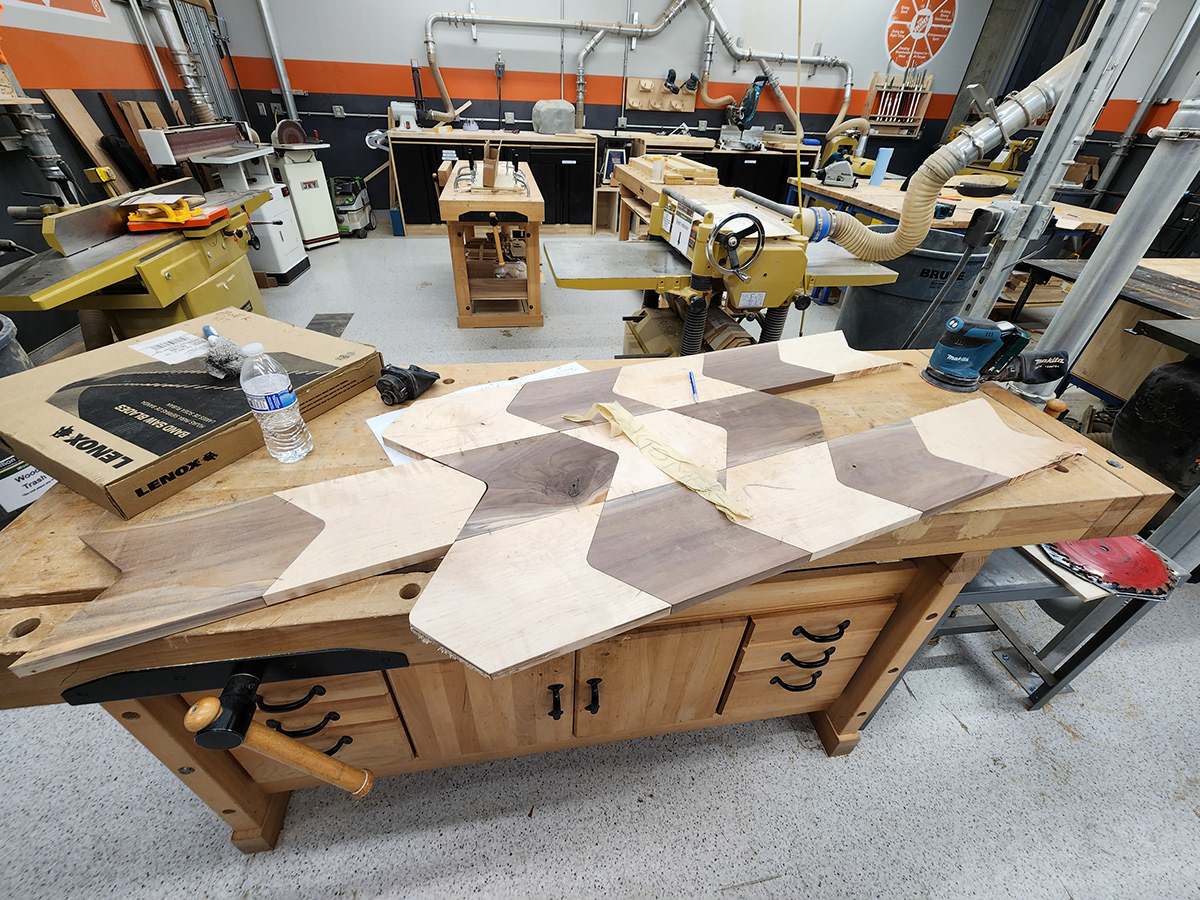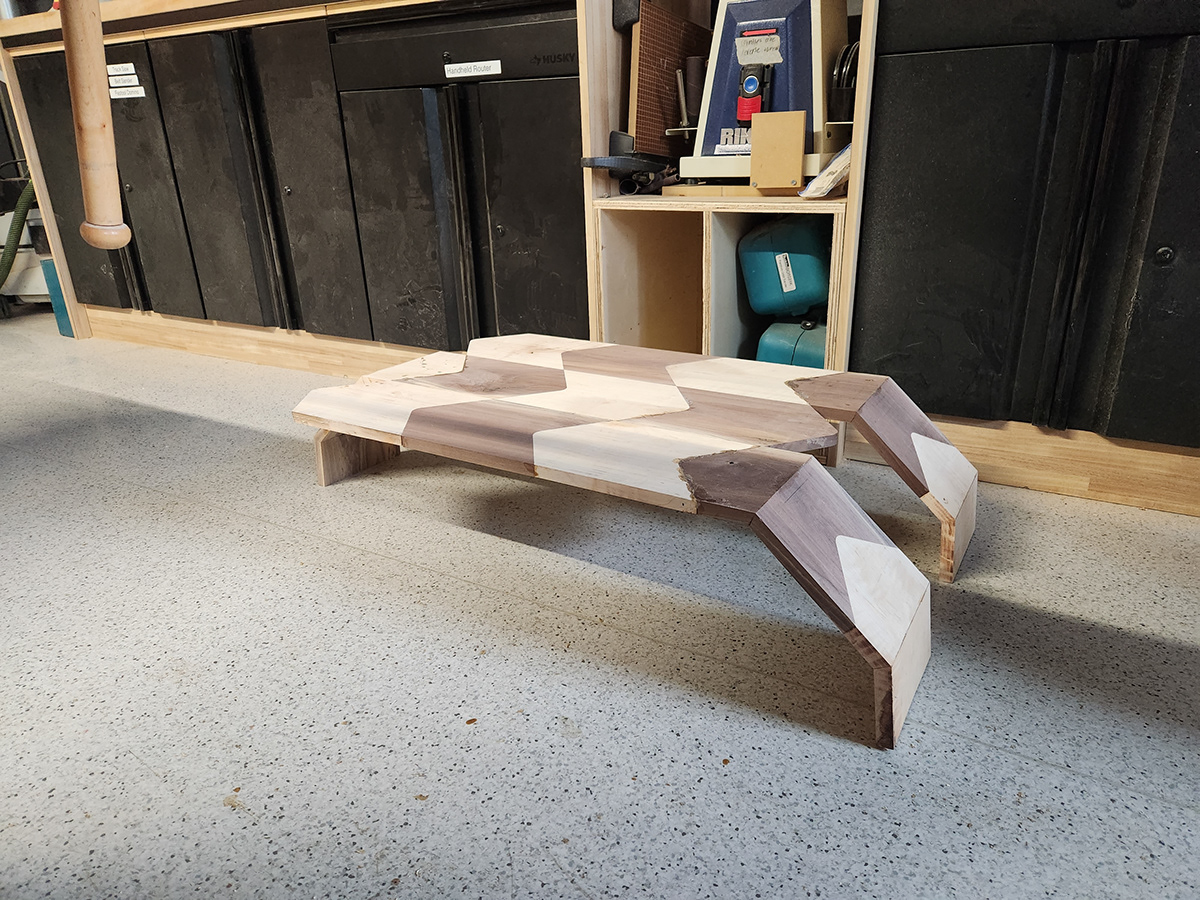The Direc-Table
By Tomek Marczewski

I've always loved woodworking. There's something beautiful about the context of wood as a living material, and the considerations one has to make when working with it make the whole process more rewarding. Wood has an attitude: it'll splinter, or warp, or deform in one of a million other ways if you don't treat it with the respect and care it so ardently craves. Dealing with that is...painful at times, but the reward speaks for itself.
My goal with this project was to create something vibrant that immediately catches the eye upon it entering one's peripheral vision. I didn't want this vibrancy to come at the cost of transformation, though - I'm a big believer in bringing out the natural beauty in wood. The way to achieve this, then, was to use two contrasting woods, and a particularly dynamic shape. The problem with many items of furniture is that they look just as static as they are - that's boring. The "chevron" shape, that repeats and interlocks with its brethren, implies movement and a direction; it guides the eye and gives the impression that there is something happening when it is looked at, while still being smooth and not jolting. With that in mind, I sketched the design for this table out, laying out the chevrons in a way that implied three separate bodies coming up out of the ground and meeting in a plane for our convenience. The design got approved, and I got to work!
The first step was to source my wood. I’m lucky enough to be located close to Carlton’s, a local wood shop, and, after perusing their selection, I decided on a length of maple and walnut, which both had nice grain and machineability, and would contrast well.
I made a mock chevron in Fusion 360, and test cut it on the CNC out of MDF to make sure the parts would fit together. After I was sure the sizing was correct, I repeated the process 16 times with the two different kinds of wood to yield all of my chevrons. This was by far the most time consuming part, as I didn’t want to go too fast and splinter the expensive wood. This process was very informative as to the CNC process, and each successive cut helped me refine things like my depth of pass, speed, or the amount of adhesion necessary to ensure that the the wood didn't come loose.
With all my wood gathered and cut, it came time to assemble. I used the Festool Domino Joiner to join rows first, then I assembled the rows into the chequerboard pattern seen in the finished product with angled dominoes in the tips of the chevrons. I glued the tabletop together with titebond wood glue, then sanded it on the drum sander to yield a smooth and even finish. I cut the domino holes for the legs too, but before gluing them in, I made two 22.5 degree cuts at corresponding places on all the legs, and trimmed off the ends to make them flat, which gave the appearance of the table coming out of the ground. Another round of gluing followed, after which all that was left to do was sanding with a palm sander at progressively higher grits, then finishing up by hand sanding with 180 grit sandpaper. Finally, I varnished it all with three layers of General Finishes Arm-R-Seal, a polyurethane varnish, sanding vigorously between every layer.

While the toolpath itself was fairly simple, I ran it very slowly to preserve the wood. That meant this part took AGES.




All the pieces were joined and assembled when I took this picture, The legs were later cut and the whole thing glued, but this was a big milestone, as there were no more weirdly angled dominoes I needed to add.

This was the first time the table stood up on its own legs. The edges were still very rough, but we were getting close.



Despite the difficulties involved, this project was a huge amount of fun, and it reminded me of why I love woodworking so much. It taught me a lot about the nature of CNC machining, and the various slight fixes I had to implement in order to overcome my numerous mistakes required a certain degree of problem solving, which was very enjoyable (at least in hindsight). This project could have been handled much more efficiently, and I think next time I'd like to make something that doesn't change the nature of the wood so much (and rather brings out the natural beauty of it), but as an involved and funky project, it was great! It'll certainly be a nice centrepiece for whatever room it ends up going in.


Made at and funded by the Georgia Tech Invention Studio

